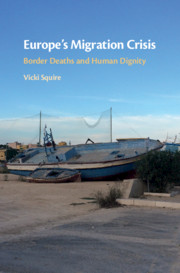Book contents
- Europe’s Migration Crisis
- Europe’s Migration Crisis
- Copyright page
- Contents
- Figures
- Acknowledgements
- Introduction
- Part I The Production of Death and Vulnerability
- Part II The Production of Solidarity and Hope
- Chapter 4 Corridoi Umanitari
- Chapter 5 Sea-Watch
- Chapter 6 Grave Dressing
- Conclusion
- Postscript
- Notes
- Bibliography
- Index
Chapter 6 - Grave Dressing
Dignity in Death and a Politics of Responsibility
from Part II - The Production of Solidarity and Hope
Published online by Cambridge University Press: 16 September 2020
- Europe’s Migration Crisis
- Europe’s Migration Crisis
- Copyright page
- Contents
- Figures
- Acknowledgements
- Introduction
- Part I The Production of Death and Vulnerability
- Part II The Production of Solidarity and Hope
- Chapter 4 Corridoi Umanitari
- Chapter 5 Sea-Watch
- Chapter 6 Grave Dressing
- Conclusion
- Postscript
- Notes
- Bibliography
- Index
Summary
This chapter examines a third pro-migration activist intervention, which involves the dressing of unmarked graves at cemeteries in which the bodies of those who died en route are buried. It situates the intervention in relation to existing instruments of containment charted in Part I and shows how grave dressing challenges biopolitical, thanatopolitical and zoopolitical dynamics of governing migration through death and vulnerability by accounting for the lives of those who have died at sea. The chapter draws on research carried out in Lampedusa and considers how cemetery activism invokes dignity in death through the naming of the deceased and the marking of graves as sites of loss and mourning. In so doing, it shows how such interventions go beyond an action for the dead alone, albeit in terms that bring to bear tensions between and within a politics of pity and a politics of empathy. By exploring different strands of cemetery activism, the chapter highlights the critical importance of those interventions that involve a refusal of racialised processes of dehumanisation and that extend practices of mourning beyond commemoration in terms that render visible the normalisation of death and vulnerability. It shows how such interventions enact dignity in death through a politics of responsibility that directly challenges authorities for a failure to account for the lives of those lost or disappeared. Grave dressing in this regard not only draws attention to the problems of a politics orientated towards the security of home, but also recreates home in more hopeful terms, through the enactment of a politics of collective responsibility for deaths at sea in solidarity with both the living and the dead.
- Type
- Chapter
- Information
- Europe's Migration CrisisBorder Deaths and Human Dignity, pp. 163 - 189Publisher: Cambridge University PressPrint publication year: 2020

